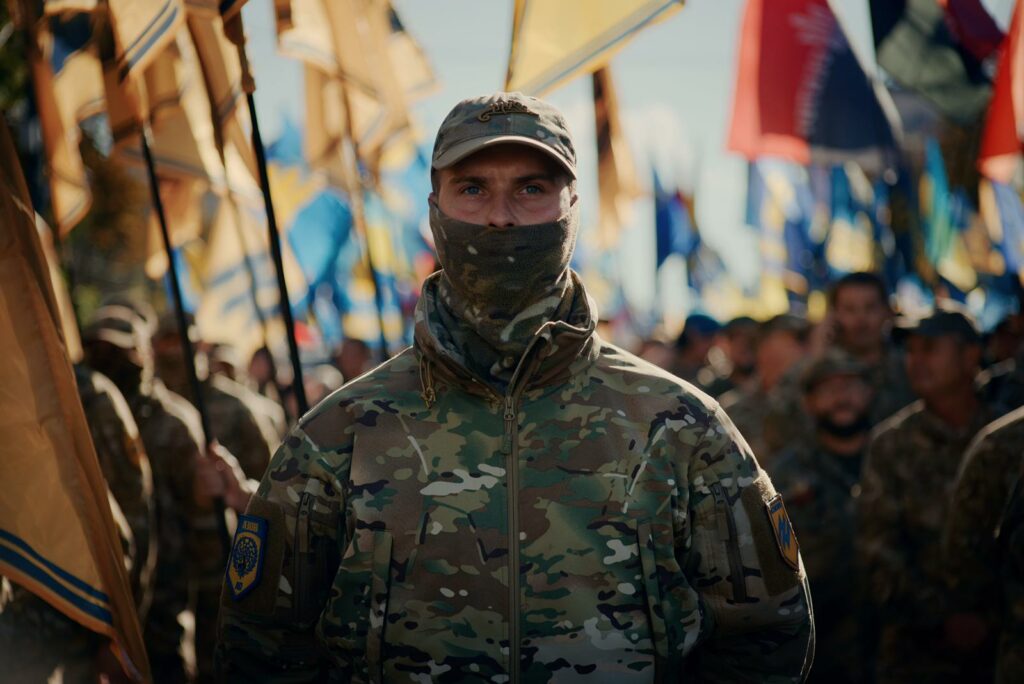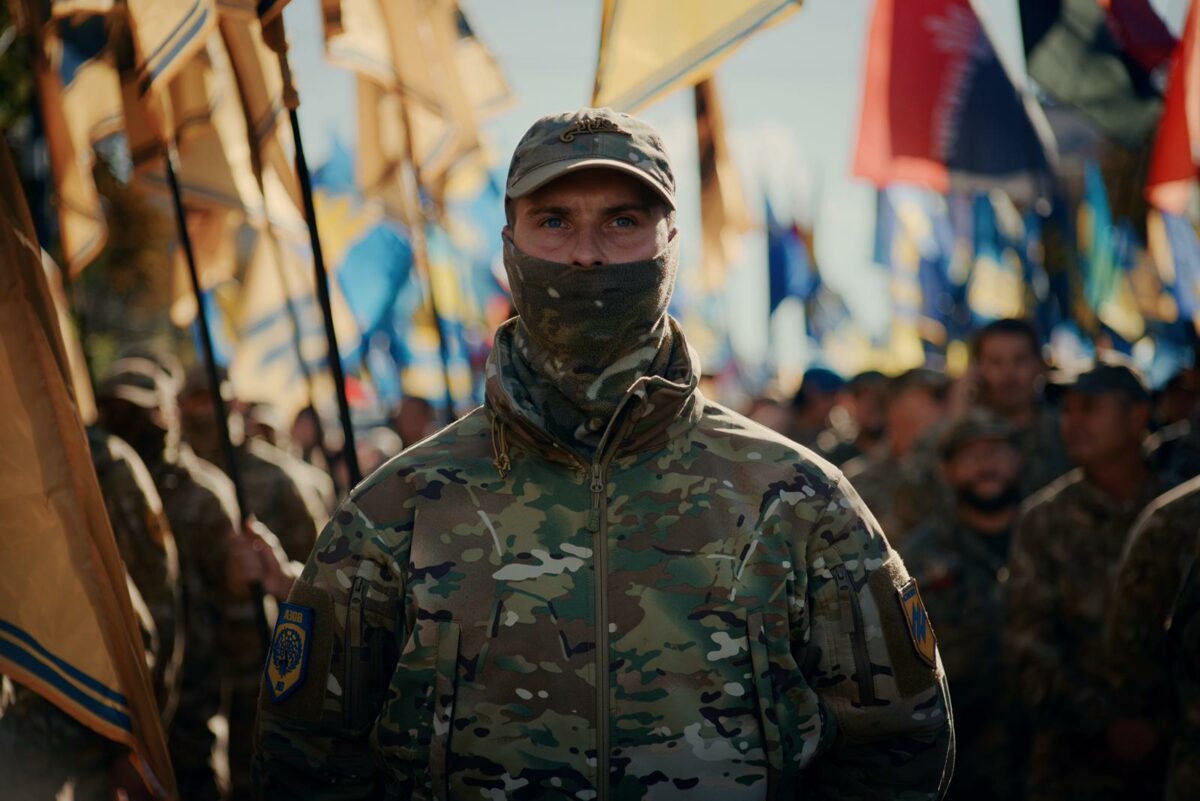As Russian aggression continues in Ukraine, the media and Western leaders continue to downplay the danger posed by the very real existence of the country’s well-organized and armed Far Right.

Note from LeftEast editors: This text was first published in French on March 7 in Révolution Permanente, then translated by Emma Lee for LeftVoice. We reprint with permission.
“Denazification” is one of Russian president Vladimir Putin’s justifications for his continued attacks on Ukraine. These declarations are pure Kremlin propagandas aimed at building a consensus, primarily within Russia itself, that legitimizes the aggression of the Putin regime.
To be sure, the Ukrainian government is reactionary, bourgeois, and pro-imperialist, but it is not actually led by Nazis. However, denying the existence of far-right nationalist organizations and the ability they’ve had since 2014 to influence Ukrainian politics only strengthens their position, posing a grave threat to the working class and oppressed in Ukraine and beyond.
Putin is effectively using half-truths to feed his narrative about Ukraine. But opposing Putin’s reactionary politics and his national oppression of Ukrainians does not mean downplaying the threat posed by reactionary Ukrainian forces. In fact, this issue is even more important now as these far-right organizations try to use the war to strengthen their political position at the national level. Analysts are already warning of this trend. Even the New York Times, which is certainly not advancing a pro-Putin line, reported:
Instability in Ukraine offers white supremacy extremists the same training opportunities that instability in Afghanistan, Iraq, and Syria has offered jihadist militants for years,” said Ali Soufan, who heads The Soufan Group, which has been documenting for several years how the conflict in eastern Ukraine has emerged as an international hub of white supremacy. … The apparent mobilization of far-right groups could be problematic for the Ukrainian government, playing into Mr. Putin’s depiction of Ukraine as a fascist country, and his false claim to be waging war against Nazis who control the government in Kyiv.
But even beyond the Kyiv government, far-right groups, several of which are openly neo-Nazi, are an important factor in this situation. Not only have they gained political and social influence since the Euromaidan movement in 2014 (despite not faring well in elections), but they have also gained important experience through training and real combat. The Far Right in Ukraine actually has thousands of people in paramilitary groups, which have been more or less integrated into the official Ukrainian army. The Far Right also organizes youth camps and has its own cultural venues. In many respects, it has more in common with fascist organizations of the 1930s — even if lacking the same political strength for now — than with the present-day Western Far Right, which is much more respectful of the legal framework imposed by their own political regimes.
The Azov Battalion and the Complicity of the West and Its Local Allies
The Azov Battalion is among the best known of these organizations internationally. Michael Colborne, a Canadian expert on the Ukrainian Far Right with a forthcoming book on the Azov movement, describes it this way in the New Statesman:
Ukraine’s far right, particularly the Azov movement, has long been able to operate with a degree of impunity and openness that makes it the envy of its international peers. The movement grew out of the Azov Regiment (originally a Battalion), formed in the chaos of war in early 2014 by a ragtag group of far-right thugs, football hooligans and international hangers-on — including dozens of Russian citizens — becoming an official unit of Ukraine’s National Guard.
With estimates of membership as high as 10,000 members … the Azov movement has been able to take advantage of a general “patriotic” turn in Ukrainian mainstream discourse since Russian aggression began in 2014. …
There’s also a bevy of loosely affiliated but more extreme subgroups under its umbrella as well, including open neo-Nazis who praise and promote violence.
It’s clear that Western imperialist leaders are aware of the political and military activity of the Far Right in Ukraine. Yet they choose not to express their concerns in public, not only because it feeds into Putin’s discourse, but also because the Far Right is aligned with their interests. However, it’s clear that the armed Far Right will play a political role in Ukraine’s future whatever the results of the war. The question for imperialism and its regional partners is whether there will be a way to control these forces and guarantee their “loyalty.”
It is no coincidence that the Azov Battalion, unlike in 2014, is trying to prove that they’re the “good guys.” To win political and military support from the imperialists, they must present themselves as trustworthy and responsible partners. That’s why they’ve adopted their “de-demonization” strategy. In Novara Media, which also quotes Colborne, we read:
The movement’s concern over its image probably also means that far-right volunteers from abroad won’t play as key a role in Azov as they did in the early phase of the war. When the conflict broke out in 2014, neo-Nazis from across Europe flocked to Ukraine to join both the Ukrainian and Russian sides. The presence of far-right fighters from abroad has been costly for Azov’s reputation. “Whereas in 2014 they were actively recruiting foreign help, this time they’re actively rejecting it,” says Colborne.
For the moment, though, the most likely scenario is that Western leaders will continue to cover up and downplay these groups’ activities — as Western politicians have been doing for years. As Al Jazeera writes, “In June 2015, both Canada and the United States announced that their own forces will not support or train the Azov regiment, citing its neo-Nazi connections. The following year, however, the US lifted the ban under pressure from the Pentagon.” Facebook, meanwhile, has recently relaxed its censorship of certain Azov propaganda.
This attitude among Western leaders and institutions creates more favorable terrain for these reactionary organizations among Ukrainians. While it’s true that not all members of the forces trained by the Azov Battalion are neo-Nazis, it is certain that their ideas have been relativized, trivialized, and spread among a large part of the population.
Pravi Sektor, the Other Far-Right Ukrainian Actor
The Azov movement and other far-right organizations benefit from the support and indulgence of the Ukrainian authorities. They even have important contacts within the state apparatus. This includes Arsen Avakov, the former Interior minister who resigned last summer and is suspected of having been the head of the Azov movement.
Pravi Sektor [Right Sector] is another important far-right group in Ukraine. Its leader, Dmytro Kotsyubaylo, has been decorated as a “hero” by the Ukrainian president himself. The Sunday Times paints this portrait of Pravi Sektor:
The group originated in 2013 as a militarised movement that included both ultra-nationalist extremists and right-wing supporters, and quickly became a mainstay in the fight against Russian-backed separatists. Though its political wing flopped, failing to secure a single seat in the 2019 elections, the Right Sector’s volunteer units are widely regarded in Ukraine as a dedicated force of patriotic volunteers committed to preserving the country’s territorial integrity. …
At home, as the threat of a Russian invasion looms, the Right Sector has found itself in an era of revitalised prestige, exemplified by Kotsyubaylo’s public recognition as a national hero. Based behind the front line as a reserve force, Right Sector fighters are training reservists and volunteers across eastern Ukraine. “We are an integrated part of our country’s defence who co-ordinate at the highest level with Ukrainian military,” Kotsyubaylo said.
There is such a strong connection between the Pravi Sektor and the Ukrainian state that it’s routine to see young schoolchildren visiting its training camps, where they are taught a totally nationalistic perspective of the country’s history. The story of Stepan Bandera’s Ukrainian Insurgent Army (UIA) is a particularly good example. The UIA was a Ukrainian nationalist military organization that fought both the Red Army and the Nazis during World War II, but collaborated with the latter. Bandera’s army was responsible for the massacre of thousands of Poles and Jews. This army’s “rehabilitation” has been underway for several years, even before the Maidan movement of 2014. As part of a reactionary revision of history that has become official policy. Banderist symbols such as the red and black flag, which we’ve even seen at demonstrations in Paris, have become regular old national symbols.
The Far Right: Private Militias of the Oligarchs?
There is a lesser-known aspect to Ukraine’s Far Right: its ties to the Ukrainian oligarchs, several of whom are among the principal financial backers of nationalist paramilitary groups. This includes the energy magnate Igor Kolomoïsky, who has financed not only the Azov Battalion but also the Dnipro 1 and Dnipro 2 militias, Aidar, and the Donbas units. As journalist Peter Cioth, a former Democratic Party operative in the United States, wrote in 2019:
During the conflict between Ukraine and Russian-backed separatists, Kolomoisky was willing to do anything to ensure his side would win- that side being, for that moment, the pro-western one. Kolomoisky is Jewish, holds Israeli citizenship in addition to his Ukrainian one, and was at one time the President of the European Council of Jewish Communities. Yet none of the above facts stopped him from funding neo-Nazi militias in Ukraine, particulary the infamous Azov Battalion, so long as they were opposed to Russia (and kept Kolomoisky-owned properties from being looted).
Kolomoïsky was sanctioned by the United States in March 2021 — not because of his financial support to neo-Nazi groups, but because he began to finance parliamentary groups whose interests were at odds with those of the West. While portraying themselves as heroic, Ukrainian leaders (including Zelenskyy himself) and the oligarchs are using the disputes between Russia and the Western imperialists to improve their negotiating position with these two “blocs.” This has been the political history of Ukraine since the fall of the USSR. Financing criminal and neo-Nazi militias to fight Russia is part of the same logic: protecting their own interests.
It may seem like a paradox that Kolomoïsky, who is Jewish, is funding groups affiliated with neo-Nazism. Some also point to the fact that because Zelenskyy is Jewish, he couldn’t possibly support or be supported by “neo-Nazis.” But all this is used to disguise that these groups were founded by individuals as reactionary as they were opportunistic, ready to set aside some of their “convictions” in favor of the highest bidder.
Thus, as the Israeli newspaper Haaretz wrote, “Its troops [of the Azov Battalion] have been accused of war crimes by the United Nations, while its paramilitary arm, the National Corps, has been linked to attacks on local Roma and members of the LGBT community. But while there has been vigilante violence by far-right groups over the past decade … violence against Jews is relatively rare.” The fact that these organizations attack Jewish populations less often does not mean that they are further from neo-Nazism — it just means that they put more emphasis on other aspects of their nauseating ideology.
What About the “Pro-Russian” Far Right?
Many would prefer to stop at denouncing the Ukrainian nationalist Far Right. Yet there is more to the story. While Putin and the Russian propaganda machine denounce the “Nazification” of Ukraine and exaggerate the actual weight of these organizations in the government, they say nothing about the far-right militants and leaders in the ranks of the “pro-Russian” Donbas militias. Despite efforts to conceal the influence of these currents within the “people’s republics,” the reality is that there are also nationalist reactionaries on the pro-Russian side.
RT has reported that “Iosif Zisels, head of Vaad Ukrainy, the Association of Jewish Organizations and Communities of Ukraine, said in 2014 that Russian neo-Nazis (including Russian National Unity) were playing an active role in the fighting in eastern Ukraine, though their ideology dates back 20 years.” Similarly, in her 2014 undercover reporting from Donbas, journalist Julia Ioffe revealed that many pro-Russian fighters wore Nazi symbols but also wanted to conceal their Nazi affiliations. She spoke with one leaders of the Vostok Battalion and recounted the following anecdote:
As Dmitry and I talked, I noticed a Vostok fighter in fatigue pants, a t-shirt, and a bulletproof vest pacing around with a Kalashnikov. He had a long, scraggly blond beard and was peppered with tattoos: a rune on one elbow, and, on the inside of his right forearm, a swastika … I asked Dmitry about it, but the man spotted me pointing to my arm.
“Come here,” he growled, beckoning angrily. I remained frozen in place.
“Don’t you go spreading your lies,” he barked as he strode toward us. “This isn’t a swastika. This is an ancient Slavic symbol. Swa is the god of the sky.”
I stared, silently.
“It’s our Slavic heritage,” he said. “It’s not a swastika.” Then he turned and walked away.
But it doesn’t stop there. There are clear official connections between authorities in the Donbas republics and the Far Right in the West. In 2014, journalist and human rights activist Halya Coynash described the list of “international observers” who came to certify the “democratic validity” of the pro-independence referendums held in Donbas: “These included at least two members of the radical right-wing populist Freedom Party of Austria: Aymeric Chauprade, adviser on international issues for the French National Front; Belgian Luc Michel, former neo-Nazi FANE member and now member of an extreme right party, as well as two compatriots from the far-right Vlaams Belang; two members of the Bulgarian far-right Ataka Party; Hungarian Bela Kovacs from the far-right Jobbik party, and others.”
You might also like: Russia Is Not Fighting an ‘Anti-fascist’ War — And Neither Is Ukraine
Russia must hide this reality to guarantee the “credibility” of its propaganda, which presents itself as the “liberators” of Ukraine’s Russian-speaking population, defending them against a Ukrainian neo-Nazi threat. Some also engage in demagoguery by denouncing the removal of Lenin statues. But this cannot hide the reactionary and oppressive nature of Putin’s regime. Nor can it hide the repeated political maneuvering of leaders in Donbas that reflect Imperial Russia before the October Revolution — such as establishing a state (New Russia) that would bring together the eastern and southern regions of Ukraine. What these neo-fascist and right-wing nationalist groups in Russia are up to is less Nazi Germany than it is Russian czarist imperialism. This lets them get away with things that are much less fraught in the West. But these currents are no less harmful than the Ukrainian neo-Nazis.
For Independent, Working-Class Politics
As this article has shown, the Far Right is a very real threat to the working class and oppressed people of Ukraine. But the threat comes not only from the reactionary Ukrainian nationalist side, but also from the “pro-Russian” side. Putin’s oppressive “Great Russian” policy only helps the development of reactionary nationalist currents in Ukraine. Russian oppression leads hundreds of thousands of people (perhaps millions) to trivialize this reactionary danger and conflate legitimate feelings abound defending their country with the political agenda of the nationalist Far Right. Meanwhile, the policies of Kyiv and the Ukrainian oligarchs promote violent anti-Russian nationalism.
Thus, one of the dangers ahead for the workers and the masses is that the war — given the current relationship of forces — could end up strengthening extreme right-wing currents, especially those collaborating closely with Ukrainian security forces. They benefit, no doubt, from NATO “military assistance” but also indirectly from imperialist political support for the Kyiv government. Because they are in many cases playing a decisive role in the defense of Ukraine, we could see these militias led by the Far Right achieve a heightened level of prestige that could extend even to Western countries.
Even if the Ukrainian government suffers a debacle, these currents could try to profit by opportunistically opposing Zelenskyy. In the event of a military victory for the “pro-Russian” Far Fight, their movement would also be strengthened.
The only way out of the war is to build an alternative — a progressive mass movement led by the working class, independent of Russia and local pro-Russian groups, Western imperialism, the national bourgeoisie, and reactionary nationalists. Adopting a revolutionary socialist perspective in the conflict would be a crucial step forward. It is the only way to guarantee national rights and a truly independent Ukraine. Otherwise, there is a high probability that reactionary forces, including those of the Far Right, will end up benefiting from the conflict.

Philippe Alcoy is a member of the editorial boards of the French website RevolutionPermanente.fr and the internationalist platform LeftEast. He researches and writes regularly on news and the history of the Balkans and Eastern Europe. Recently, he published “Hongrie 1956: les jours où les travailleurs ont défié le stalinisme” about the Council Revolution of 1956 in Hungary.

